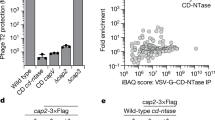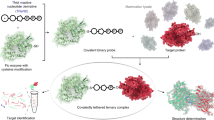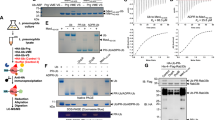Abstract
The Fic family of adenylyltransferases, defined by a core HPFx(D/E)GN(G/K)R motif, consists of over 2,700 proteins found in organisms from bacteria to humans. The immunoglobulin-binding protein A (IbpA) from the bacterial pathogen Histophilus somni contains two Fic domains that adenylylate the switch1 tyrosine residue of Rho-family GTPases, allowing the bacteria to subvert host defenses. Here we present the structure of the second Fic domain of IbpA (IbpAFic2) in complex with its substrate, Cdc42. IbpAFic2-bound Cdc42 mimics the GDI-bound state of Rho GTPases, with both its switch1 and switch2 regions gripped by IbpAFic2. Mutations disrupting the IbpAFic2–Cdc42 interface impair adenylylation and cytotoxicity. Notably, the switch1 tyrosine of Cdc42 is adenylylated in the structure, providing the first structural view for this post-translational modification. We also show that the nucleotide-binding mechanism is conserved among Fic proteins and propose a catalytic mechanism for this recently discovered family of enzymes.
This is a preview of subscription content, access via your institution
Access options
Subscribe to this journal
Receive 12 print issues and online access
$189.00 per year
only $15.75 per issue
Buy this article
- Purchase on Springer Link
- Instant access to full article PDF
Prices may be subject to local taxes which are calculated during checkout






Similar content being viewed by others
References
http://www.ebi.ac.uk/interpro/IEntry?ac=IPR003812. InterPro: IPR003812 Filamentation induced by cAMP/death on curing, related. (2010).
Worby, C.A. et al. The fic domain: regulation of cell signaling by adenylylation. Mol. Cell 34, 93–103 (2009).
Yarbrough, M.L. et al. AMPylation of Rho GTPases by Vibrio VopS disrupts effector binding and downstream signaling. Science 323, 269–272 (2009).
Zekarias, B. et al. Histophilus somni IbpA DR2/Fic in virulence and immunoprotection at the natural host alveolar epithelial barrier. Infect. Immun. 78, 1850–1858 (2010).
Lehnherr, H., Maguin, E., Jafri, S. & Yarmolinsky, M.B. Plasmid addiction genes of bacteriophage P1: doc, which causes cell death on curing of prophage, and phd, which prevents host death when prophage is retained. J. Mol. Biol. 233, 414–428 (1993).
Liu, M., Zhang, Y., Inouye, M. & Woychik, N.A. Bacterial addiction module toxin Doc inhibits translation elongation through its association with the 30S ribosomal subunit. Proc. Natl. Acad. Sci. USA 105, 5885–5890 (2008).
Magnuson, R. & Yarmolinsky, M.B. Corepression of the P1 addiction operon by Phd and Doc. J. Bacteriol. 180, 6342–6351 (1998).
Roy, C.R. & Mukherjee, S. Bacterial FIC proteins AMP up infection. Sci. Signal. 2, pe14 (2009).
Schmid, M.C. et al. A translocated bacterial protein protects vascular endothelial cells from apoptosis. PLoS Pathog. 2, e115 (2006).
Xu, R.Q. et al. AvrAC(Xcc8004), a type III effector with a leucine-rich repeat domain from Xanthomonas campestris pathovar campestris confers avirulence in vascular tissues of Arabidopsis thaliana ecotype Col-0. J. Bacteriol. 190, 343–355 (2008).
May, B.J. et al. Complete genomic sequence of Pasteurella multocida, Pm70. Proc. Natl. Acad. Sci. USA 98, 3460–3465 (2001).
Lee, C.C. et al. Crystal structure of the type III effector AvrB from Pseudomonas syringae. Structure 12, 487–494 (2004).
Desveaux, D. et al. Type III effector activation via nucleotide binding, phosphorylation, and host target interaction. PLoS Pathog. 3, e48 (2007).
Kinch, L.N., Yarbrough, M.L., Orth, K. & Grishin, N.V. Fido, a novel AMPylation domain common to fic, doc, and AvrB. PLoS One 4, e5818 (2009).
Stadtman, E.R., Shapiro, B.M., Kingdon, H.S., Woolfolk, C.A. & Hubbard, J.S. Cellular regulation of glutamine synthetase activity in Escherichia coli. Adv. Enzyme Regul. 6, 257–289 (1968).
Brown, M.S., Segal, A. & Stadtman, E.R. Modulation of glutamine synthetase adenylylation and deadenylylation is mediated by metabolic transformation of the P II -regulatory protein. Proc. Natl. Acad. Sci. USA 68, 2949–2953 (1971).
Hochstrasser, M. Origin and function of ubiquitin-like proteins. Nature 458, 422–429 (2009).
Kerscher, O., Felberbaum, R. & Hochstrasser, M. Modification of proteins by ubiquitin and ubiquitin-like proteins. Annu. Rev. Cell Dev. Biol. 22, 159–180 (2006).
Shuman, S. & Lima, C.D. The polynucleotide ligase and RNA capping enzyme superfamily of covalent nucleotidyltransferases. Curr. Opin. Struct. Biol. 14, 757–764 (2004).
Shuman, S. DNA ligases: progress and prospects. J. Biol. Chem. 284, 17365–17369 (2009).
Das, D. et al. Crystal structure of the Fic (filamentation induced by cAMP) family protein SO4266 (gi,24375750) from Shewanella oneidensis MR-1 at 1.6 Å resolution. Proteins 75, 264–271 (2009).
Tagawa, Y. et al. Genetic and functional analysis of Haemophilus somnus high molecular weight-immunoglobulin binding proteins. Microb. Pathog. 39, 159–170 (2005).
Scheffzek, K., Stephan, I., Jensen, O.N., Illenberger, D. & Gierschik, P. The Rac-RhoGDI complex and the structural basis for the regulation of Rho proteins by RhoGDI. Nat. Struct. Biol. 7, 122–126 (2000).
Hoffman, G.R., Nassar, N. & Cerione, R.A. Structure of the Rho family GTP-binding protein Cdc42 in complex with the multifunctional regulator RhoGDI. Cell 100, 345–356 (2000).
Luong, P. et al. Kinetic and structural insights into the mechanism of AMPylation by VopS FIC domain. J. Biol. Chem. 285, 20155–20163 (2010).
Hirsch, A.K., Fischer, F.R. & Diederich, F. Phosphate recognition in structural biology. Angew. Chem. Int. Edn Engl. 46, 338–352 (2007).
Hoshinoo, K., Sasaki, K., Tanaka, A., Corbeil, L.B. & Tagawa, Y. Virulence attributes of Histophilus somni with a deletion mutation in the ibpA gene. Microb. Pathog. 46, 273–282 (2009).
Prehna, G., Ivanov, M.I., Bliska, J.B. & Stebbins, C.E. Yersinia virulence depends on mimicry of host Rho-family nucleotide dissociation inhibitors. Cell 126, 869–880 (2006).
Galan, J.E. Common themes in the design and function of bacterial effectors. Cell Host Microbe 5, 571–579 (2009).
Elde, N.C. & Malik, H.S. The evolutionary conundrum of pathogen mimicry. Nat. Rev. Microbiol. 7, 787–797 (2009).
DerMardirossian, C. & Bokoch, G.M. GDIs: central regulatory molecules in Rho GTPase activation. Trends Cell Biol. 15, 356–363 (2005).
Rossman, K.L. et al. A crystallographic view of interactions between Dbs and Cdc42: PH domain-assisted guanine nucleotide exchange. EMBO J. 21, 1315–1326 (2002).
Lammers, M., Meyer, S., Kuhlmann, D. & Wittinghofer, A. Specificity of interactions between mDia isoforms and Rho proteins. J. Biol. Chem. 283, 35236–35246 (2008).
Yang, J., Zhang, Z., Roe, S.M., Marshall, C.J. & Barford, D. Activation of Rho GTPases by DOCK exchange factors is mediated by a nucleotide sensor. Science 325, 1398–1402 (2009).
Acknowledgements
We are grateful to the University of California, San Diego X-ray facility staff and the Advanced Light Source (beam line 8.2.1) staff of Lawrence Berkeley National Laboratory for beam access and help with data collection, Z. Xu and X. Guo for critically reading the manuscript and members of the Dixon laboratory for helpful discussions. This work was supported by US National Institutes of Health grant AI060662 to J.E.D.
Author information
Authors and Affiliations
Contributions
J.X. performed most of the research; S.M. purified VopS protein; B.S. collected diffraction data for IbpAFic2-alone crystals; J.X., C.A.W., S.M. and J.E.D. designed the research, analyzed data and wrote the manuscript.
Corresponding author
Ethics declarations
Competing interests
The authors declare no competing financial interests.
Supplementary information
Supplementary Text and Figures
Supplementary Figures 1–9, Supplementary Table 1 and Supplementary Methods (PDF 737 kb)
Rights and permissions
About this article
Cite this article
Xiao, J., Worby, C., Mattoo, S. et al. Structural basis of Fic-mediated adenylylation. Nat Struct Mol Biol 17, 1004–1010 (2010). https://doi.org/10.1038/nsmb.1867
Received:
Accepted:
Published:
Issue Date:
DOI: https://doi.org/10.1038/nsmb.1867
This article is cited by
-
Specificity of AMPylation of the human chaperone BiP is mediated by TPR motifs of FICD
Nature Communications (2021)
-
Structures of a deAMPylation complex rationalise the switch between antagonistic catalytic activities of FICD
Nature Communications (2021)
-
Kinetic and structural parameters governing Fic-mediated adenylylation/AMPylation of the Hsp70 chaperone, BiP/GRP78
Cell Stress and Chaperones (2021)
-
Identification of targets of AMPylating Fic enzymes by co-substrate-mediated covalent capture
Nature Chemistry (2020)
-
A Ca2+-regulated deAMPylation switch in human and bacterial FIC proteins
Nature Communications (2019)



